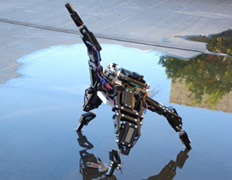The sea star-robot studies to go and limp
 Lets take for an example a dog who had interrupted one paw. It is improbable, that dog will rise as driven or will fall to the ground. More likely dog, having taken advantage of three healthy paws, will escape in a safe place. And here for the majority of independent robots damage of a leg of death similarly to. However, one machine on an example of a dog managed to something to be learned.
Lets take for an example a dog who had interrupted one paw. It is improbable, that dog will rise as driven or will fall to the ground. More likely dog, having taken advantage of three healthy paws, will escape in a safe place. And here for the majority of independent robots damage of a leg of death similarly to. However, one machine on an example of a dog managed to something to be learned.To Troy the American researchers - Josh Bongard from university of Vermont (UVM), and also Victor Zykov and Course Hod Lipson from Cornell University - have published in magazine Science article in which have described the four-footed robot similar to a starfish capable without assistance to recover from "wound" by means of modelling.
" We still have not given this robot of the official name, but among themselves usually we call it the Starfish, and we does not confuse, that at the true starfish five legs, instead of four, - has told Bongard. - Generally, the alive starfish is much better than our robot regarding restoration after damages because she actually can grow up anew legs ".
Authors of work write, that their machine uses intercoupling " perception - actuating " to study an own structure and subsequently to use this " self-model " for movement. And when the part of a leg is removed, the robot adapts the model for creation alternative " gait ". This concept can help with design of new difficult machines and throw light on " self-modelling " at animals.
In other words, instead of giving the robot a set of rigid instructions, researchers allow the machine" to open own nature " - to solve, how to operate themselves: first the robot learns itself to go, and in case of damage - to limp.
" The majority of robots has the fixed model - the program incorporated by engineers, - explains Lipson. - We for the first time have shown, how the model can appear inside of the robot. It makes machines adaptive at a new level because it is possible to set the task of them, not caring about creation of the program for its performance.
So, at the first stage the robot "knows", it consists of what parts, however "does not understand", how they are arranged and as them to use for performance of the main task - movements forward.
"At first the robot at all does not know, on what it is similar. Everything, that is known to it, - it can be the snake, a tree or something else ", - explains Lipson.
To understand itself to the machine the scientific method helps: the theory - experiment - the advanced theory - other experiment, and so on.
As a result the robot starts to create a series of computer models of own arrangement, jointing the parts in the casual image. After that the machine develops control words, which it could give engines to check up the created models.
Then there comes the key moment: the robot chooses control words to receive result depending on which will estimate the created model. Then the machine executes these control words and reconsiders model. It is a cycle 16 times repeat, and as a result the robot tries to move from a place.
" The machine does not have any uniform model of - it simultaneously has a set of variants which compete with each other ", - speaks Lipson. As a result the robot develops awkward, but quite functional gait, and the most effective variant while is the way at which the robot bases on "stomach", tightens the body, makes a start "back" legs, rolls over, rolled. It is difficult to describe words, but it is really similar to movement of a starfish.
But here engineers delete a part of one leg, and the robot, "understanding", that cannot move, anew starts to build and check 16 models "to invent" new gait. With all this "starfish" is helped by the virtual version itself ", which the robot builds to observe own movements. Each time when the machine makes a step, it updates this model "hurriedly" and uses it for a following step.
Bongard considers, that the robot, somewhat, "is conscious" at a primitive level because it " thinks of itself ". Researchers, meanwhile, recognize, that the robot in itself idle time, and successes while modest, but the basic algorithm can be already applied in much more difficult machines to allow them to adapt to changes in a surrounding medium and independently to repair itself, replacing details.
" Robots on other planets should be able to continue the mission without human intervention in case of, If they are damaged and cannot inform on a problem to the Earth ", - has noticed Bongard, and it is difficult to disagree with it.



0 Comments:
Post a Comment
<< Home